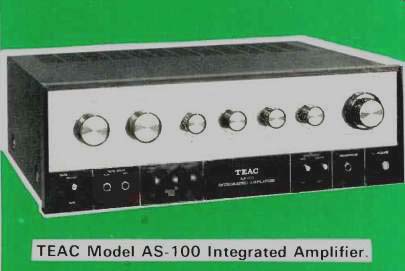
MANUFACTURER'S SPECIFICATIONS
POWER AMPLIFIER SECTION
Rated Power: 30 watts/channel, 8-ohm loads, both channels driven; 40 watts/channel, 8-ohm loads, single channel driven.
THD: 0.2% at rated output; below 0.1% at 0.1 watt.
IM Distortion: Less than 0.2% at rated output.
Power Bandwidth: 10 to 40,000 Hz.
Frequency Response: 5 to 200,000 Hz, +0,-2 dB.
S/N Ratio: Better than 90 dB.
Residual System Noise: Less than 0.3 mV.
Input Sensitivity: 1V.
PREAMPLIFIER SECTION
Input Sensitivity: Phono 1, 2, 2 mV; Tuner, 1 50 mV; Aux 1, 2, Tape, 1 50 mV.
Output Level: Preamp-out, 1 Volt at rated inputs; Record Out, 150 mV at rated inputs.
Frequency Response: 10 to 50,000 Hz,-1 dB.
S/N Ratio: Phono 1, 2, 70 dB; AUX 1, 2, 80 dB.
Tone Control Range: Bass, +/-10 dB @ 100 Hz; Treble, +/-10 dB @ 10 kHz.
Filter Characteristics: Low Cut, 100 Hz, 6 dB/octave; High Cut, 8 kHz, 6 dB/octave.
GENERAL SPECIFICATIONS
Power Consumption: 15 watts @ no signal; 160 watts @ rated power.
Dimensions: 1 6-1 /8 in. W. x 5-9/16 in. H. x 1 2-1 5/ 1 6 in. D.
Weight: 22 lbs.
Price: $299.50.
Although I have had an opportunity to work the TEAC recording equipment in the past (both their TCA-43 4-channel open-reel job and their excellent new Model 350 cassette deck), this was the first time we checked an integrated amplifier designed and produced by a company more noted for its excellent tape products. Like its bigger brother, the Model AS-20I (Reviewed in AUDIO, March 1972), the Model AS-I00 has much to commend it in its particular power and price class. The front panel, shown in the photo, is black and light gold in color, surrounded by heavy extruded black framing.
Major controls include a five-position source selector switch (a pair of PHONOS, TUNER, and two AUX positions. Individual left-channel and right-channel BASS and TREBLE controls are each of the switch-step type (rather than continuously variable rotary controls) and each provides accurately calibrated 2 dB steps of boost or attenuation at the reference frequencies of 100 Hz (for the BASS controls) and 10 kHz (for the TREBLE pair). Master VOLUME and BALANCE controls are concentrically mounted at the upper right of the panel. Secondary switches and facilities along the bottom edge of the panel include a TAPE-MONITOR Switch, TAPE IN and OUT jacks (in parallel with tape jacks on the rear panel), HIGH-CUT, LOW-CUT filter switches, LOUDNESS switch, MAIN and REMOTE speaker on-off switches, a stereo headphone jack and a push-push POWER on/off switch.
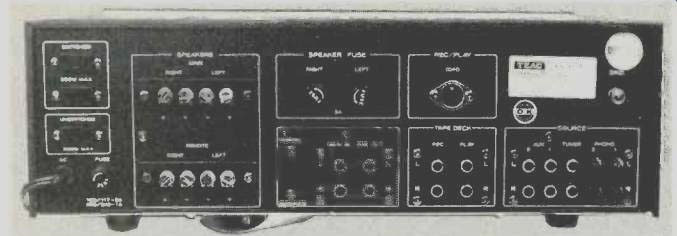
Fig. 1-Rear panel.
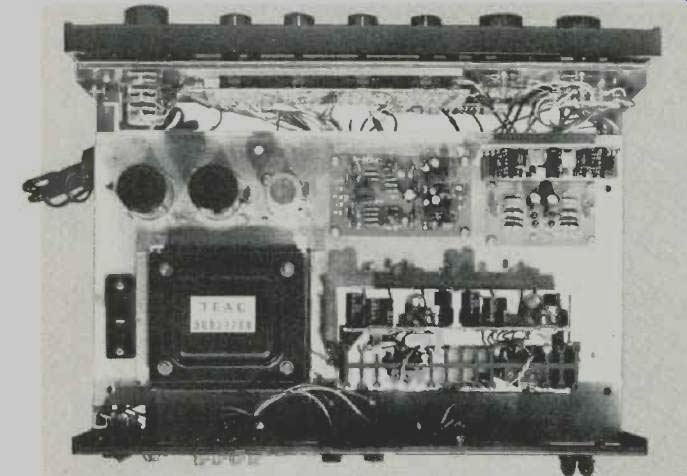
Fig. 2A-View from above.

Fig. 2B-View from beneath.
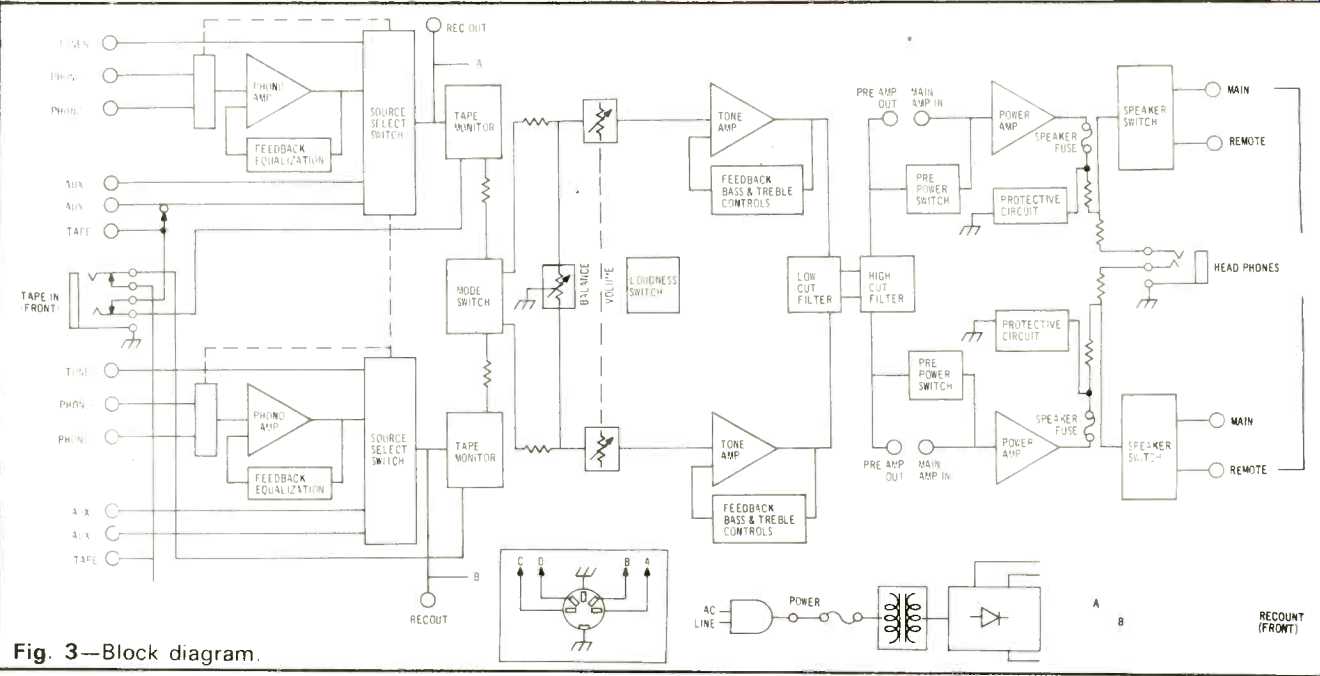
Fig. 3-Block diagram.
The rear panel, shown in Fig. 1, features three convenience a.c. outlets (two switched, one unswitched), speaker terminals for connection of main and/or remote pairs of stereo speaker systems, a power line fuse, left and right channel speaker fuses, TAPE RECORD and PLAY jacks, input pairs for TUNER, AUX1, AUX2, and PHONO1 and 2. A slide switch enables the user to separate the preamplifier and power amplifier circuits and there are PRE OUT and MAIN IN jacks next to it so that the equipment can really be used as two separate audio components (as part of an electronic cross-over system, using extra amplifiers, or to insert any of the many devices which belong between the preamp-control chassis and the main power amplifier). A DIN record-play connector (for similarly equipped tape recorders) and a ground terminal complete the rear panel layout.
Views of the topside and bottom-side of this thoughtfully laid out chassis are shown in Fig. 2. The well proportioned dual heat sink arrangement, housing the power output devices, can be seen in Fig. 2A as can the relatively large size of the power transformer (considering the fact that the unit is, by today's standards, a medium powered amplifier). Modular p.c. board construction is used throughout, with the preamplifier module placed well away from any hum-inducing power supply components. While we were not supplied with a full schematic diagram of this amplifier, a block diagram supplied in the owner's manual is reproduced in Fig. 3. Note that the tone control circuits are of the preferred feedback type and that, in addition to the externally accessible speaker fuses, output protective electronic circuits are incorporated in each power amplifier channel.
Electrical Measurements
It has become increasingly important, in recent years, to "qualify" power ratings when discussing an integrated amplifier. A mere statement of "30 watts per channel" (even assuming that one has gotten past the "peak," "dynamic," and "IHF music power" ambiguities) still does not tell the whole story. There are 30 watt amplifiers that fail to drive even moderately efficient speakers and there are other 30 watt per channel amplifiers that seem to put out more clean power than their manufacturers claim. The TEAC AS-100 fits in the latter category, and the reasons become apparent as you examine the curves which resulted from our measurements. Of increasing importance is a set of measurements which we began showing less than a year ago-that of distortion versus frequency at various power levels. These curves are not a requirement in the IHF standards but, hopefully, if and when the standards are revised they could possibly become the most important measurements of all. As you can see in Fig. 4, distortion at 30 watts per channel (with both channels driven into 8 ohm loads) is all but unmeasurable at all frequencies above 30 Hz and below 15 kHz (our generator has "built in distortion" of about 0.5%) and at the very extremes of 20 Hz and 20 kHz, the THD measures 0.25% and 0.2% respectively. At the half-power point of 15 watts per channel, the only meaningful measurement we could get was at 20 kHz, where THD measured 0.15%-still well below the 0.2% rated THD which TEAC conservatively quotes for mid-band. At all levels below 15 watts per channel, we could not get a significant distortion reading at any frequency in the audio range, owing to the limitations of our own audio generator. The manufacturer includes published curves for frequencies of 40 Hz, 1 kHz and 10 kHz at levels of power up to and beyond rated output and from these we were able to read figures no greater than 0.04% at any power level from as little as 0.1 watt up to and including 30 watts per channel. The low power level readings are just as significant as the power levels near rated output, since many amplifiers exhibit a rising distortion characteristic in the milliwatt regions of power output.

Fig. 4--Distortion vs. frequency at two power levels.

Fig. 5--Mid-band THD and IM characteristics.
As for mid-band power output capability, shown in the curves of Fig. 5, 45 watts of power per channel (again, with both channels driven) was obtained before the rated THD of 0.2% was reached. Rated IM distortion (0.2%) was reached at a power output of just over 40 watts per channel. Again, lower power outputs resulted in IM readings below the capability of our test equipment, whose limit is known to be around 0.08%, but the manufacturer's published curve shows IM levels of around 0.05% at all lower power levels down to 0.1 watts.
Power bandwidth extends from 8 Hz to 42 kHz, a bit better than claimed by the manufacturer, as shown in Fig. 6. Tone control characteristics, as well as filter characteristics are plotted in Fig. 7 and, since the tone controls are of the switching type, we plotted the full response at each discrete setting, rather than just the "end points" of each control. Note that at 100 Hz and 10 kHz, the curves are exactly two dB apart as claimed.
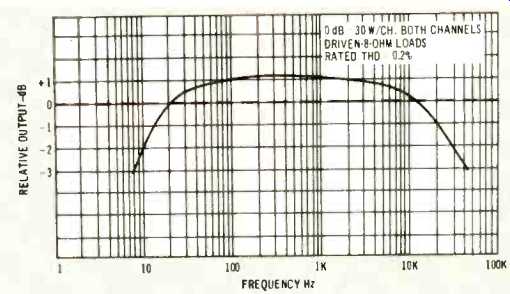
Fig. 6-Power bandwidth.
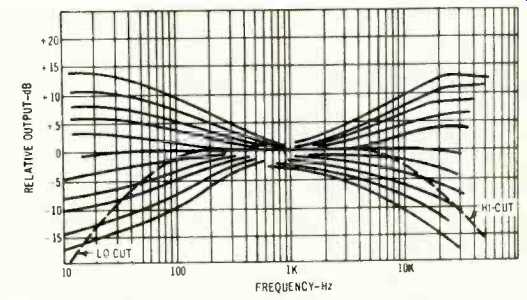
Fig. 7-Tone control and filter characteristics.
Listening Tests
We used the Teac AS-100 amplifier for about two weeks, both as a primary system (with low-efficiency air-suspension type speaker systems in a 15 ft. x 20 ft. listening room) and to drive the rear speakers in our new four-channel array. As a primary system, the amplifier seemed to deliver more clean power than its nominal power rating would suggest. Excellent bass reproduction and good transients and attack time were a significant contribution of the amplifier (our speakers have been in use for a long time with many amplifiers, so we do have some basis of comparison here). We particularly were interested in the use of the AS-100 as a rear amplifier in four-channel arrays, since, at its price, this amplifier is very likely to find its way into the homes of "all-in-one receiver" owners who are ready for the step-up to four channel. Our particular receiver has a power rating of 45 watts per channel (nominal) rms, yet we found the AS-100 completely compatible as a "rear" amplifier at all dynamic levels using a wide variety of four-channel discrete and matrixed source material. In all, a very fine medium power jobs whose performance rivals that of many higher-powered, more expensive integrated amplifier components.
-Leonard Feldman
=================
(Adapted from Audio magazine, Jan. 1973)
Also see:
TEAC AS-201 Integrated Amplifier (Mar. 1972)
Teac Model AS-200U Amplifier (Equip. Profile, Apr. 1970)
TEAC Model AT-100 Stereo FM Tuner (Jun. 1973)
= = = =